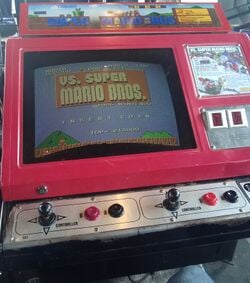VS. System: Difference between revisions
No edit summary |
No edit summary |
||
| Line 6: | Line 6: | ||
}} | }} | ||
The '''VS. System''' is a collection of coin-operated VS. UniSystem or VS. DualSystem arcade systems that first appeared in 1984. As their name implies, the video games are designed for competitive play. The VS. UniSystem is like a conventional upright arcade cabinet with two sets of controls and a single screen. The VS. UniSystem can either come as a dedicated gray cabinet or be a conversion from ''[[Donkey Kong (game)|Donkey Kong]]'', ''[[Donkey Kong Jr. (game)|Donkey Kong Jr.]]'', or ''{{wp|Popeye (game)|Popeye}}'' cabinets. It is not possible to convert the dedicated wide-body ''[[Mario Bros. (game)|Mario Bros.]]'' cabinets or the ''{{wp|Punch-Out!! (arcade game)|Punch-Out!!}}'' cabinets. The VS. DualSystem comes with two screens and four sets of controls. Although these cabinets were designed for up to four simultaneous players, only the launch title, ''{{wp|Tennis (1984 video game)|VS. Tennis}}'', takes advantage of this capability. The upright type looks like two machines conjoined at an angle while the sit-down type is red and lets players face each other. The latter was renamed VS. Table.<ref>[https://archive.org/details/vsdr.mario/mode/1up ''VS. Dr. Mario'' installation manual]</ref> The VS. Table is the earliest VS. System form factor and is the most common one found in Japan.<ref name=May86GM>[https://onitama.tv/gamemachine/pdf/19860501p.pdf#page=11 "Jaleco Ships New Game For "VS. System"" (Paragraph 1)]. Game Machine. Amusement Press. Published May 1, 1986.</ref> It was unveiled in January 1984 and became available the following month.<ref name=February84GM></ref> | The '''VS. System''' is a collection of coin-operated VS. UniSystem or VS. DualSystem arcade systems that first appeared in 1984. As their name implies, the video games are designed for competitive play. The VS. UniSystem is like a conventional upright arcade cabinet with two sets of controls and a single screen. The VS. UniSystem can either come as a dedicated gray cabinet or be a conversion from ''[[Donkey Kong (game)|Donkey Kong]]'', ''[[Donkey Kong Jr. (game)|Donkey Kong Jr.]]'', or ''{{wp|Popeye (game)|Popeye}}'' cabinets. It is not possible to convert the dedicated wide-body ''[[Mario Bros. (game)|Mario Bros.]]'' cabinets or the ''{{wp|Punch-Out!! (arcade game)|Punch-Out!!}}'' cabinets. In Japan, there are conversion kits for cocktail cabinets.<ref>{{media link|VS. Golf Pinball Japanese flyer back.jpg|Cocktail conversion kit flyer}}</ref> The VS. DualSystem comes with two screens and four sets of controls. Although these cabinets were designed for up to four simultaneous players, only the launch title, ''{{wp|Tennis (1984 video game)|VS. Tennis}}'', takes advantage of this capability. The upright type looks like two machines conjoined at an angle while the sit-down type is red and lets players face each other. The latter was renamed VS. Table.<ref>[https://archive.org/details/vsdr.mario/mode/1up ''VS. Dr. Mario'' installation manual]</ref> The VS. Table is the earliest VS. System form factor and is the most common one found in Japan.<ref name=May86GM>[https://onitama.tv/gamemachine/pdf/19860501p.pdf#page=11 "Jaleco Ships New Game For "VS. System"" (Paragraph 1)]. Game Machine. Amusement Press. Published May 1, 1986.</ref> It was unveiled in January 1984 and became available the following month.<ref name=February84GM></ref> | ||
The VS. System was designed in response to the {{wp|video game crash of 1983}}, which saw arcade machine operators facing declining revenue while taking big risks in each new purchase. [[Nintendo]] responded by creating the Nintendo-Pak conversion kits for ''Mario Bros.'' in addition to selling the dedicated wide-body cabinets.<ref>[https://archive.org/details/mariobrospak/mode/1up ''Mario Bros.'' Nintendo-Pak'' manual]</ref> ''[[Donkey Kong 3]]'' was available only as a Nintendo-Pak, which spared operators from having to buy the cabinet.<ref>[https://archive.org/details/donkeykong3/mode/1up ''Donkey Kong 3'' Nintendo-Pak manual]</ref> The VS. System goes further by having a cabinet and PCB that allowed operators to easily swap the PPUs and ROMs for each new release with a VS.-Pak. The cost savings led to the purchase of around a hundred thousand machines and conversion kits in the US alone by 1986.<ref>[https://archive.org/details/play-meter-volume-12-number-5-april-1986-600DPI/Play%20Meter%20-%20Volume%2012%2C%20Number%205%20-%20April%201986%20%28Compressed%29/page/9/mode/1up ''Play Meter''. April 1, 1986 issue, page 9.]</ref> Its success spurred the development of the [[Nintendo PlayChoice-10]]. | The VS. System was designed in response to the {{wp|video game crash of 1983}}, which saw arcade machine operators facing declining revenue while taking big risks in each new purchase. [[Nintendo]] responded by creating the Nintendo-Pak conversion kits for ''Mario Bros.'' in addition to selling the dedicated wide-body cabinets.<ref>[https://archive.org/details/mariobrospak/mode/1up ''Mario Bros.'' Nintendo-Pak'' manual]</ref> ''[[Donkey Kong 3]]'' was available only as a Nintendo-Pak, which spared operators from having to buy the cabinet.<ref>[https://archive.org/details/donkeykong3/mode/1up ''Donkey Kong 3'' Nintendo-Pak manual]</ref> The VS. System goes further by having a cabinet and PCB that allowed operators to easily swap the PPUs and ROMs for each new release with a VS.-Pak. The cost savings led to the purchase of around a hundred thousand machines and conversion kits in the US alone by 1986.<ref>[https://archive.org/details/play-meter-volume-12-number-5-april-1986-600DPI/Play%20Meter%20-%20Volume%2012%2C%20Number%205%20-%20April%201986%20%28Compressed%29/page/9/mode/1up ''Play Meter''. April 1, 1986 issue, page 9.]</ref> Its success spurred the development of the [[Nintendo PlayChoice-10]]. | ||
Revision as of 17:02, October 18, 2022
| VS. System | |
|---|---|

| |
| Release date | February 1984[1] |
| Discontinued | 1990 |
| Successor | Nintendo PlayChoice-10 |
The VS. System is a collection of coin-operated VS. UniSystem or VS. DualSystem arcade systems that first appeared in 1984. As their name implies, the video games are designed for competitive play. The VS. UniSystem is like a conventional upright arcade cabinet with two sets of controls and a single screen. The VS. UniSystem can either come as a dedicated gray cabinet or be a conversion from Donkey Kong, Donkey Kong Jr., or Popeye cabinets. It is not possible to convert the dedicated wide-body Mario Bros. cabinets or the Punch-Out!! cabinets. In Japan, there are conversion kits for cocktail cabinets.[2] The VS. DualSystem comes with two screens and four sets of controls. Although these cabinets were designed for up to four simultaneous players, only the launch title, VS. Tennis, takes advantage of this capability. The upright type looks like two machines conjoined at an angle while the sit-down type is red and lets players face each other. The latter was renamed VS. Table.[3] The VS. Table is the earliest VS. System form factor and is the most common one found in Japan.[4] It was unveiled in January 1984 and became available the following month.[1]
The VS. System was designed in response to the video game crash of 1983, which saw arcade machine operators facing declining revenue while taking big risks in each new purchase. Nintendo responded by creating the Nintendo-Pak conversion kits for Mario Bros. in addition to selling the dedicated wide-body cabinets.[5] Donkey Kong 3 was available only as a Nintendo-Pak, which spared operators from having to buy the cabinet.[6] The VS. System goes further by having a cabinet and PCB that allowed operators to easily swap the PPUs and ROMs for each new release with a VS.-Pak. The cost savings led to the purchase of around a hundred thousand machines and conversion kits in the US alone by 1986.[7] Its success spurred the development of the Nintendo PlayChoice-10.
The games are mostly ports of Nintendo Entertainment System home console games, although many have notable changes in their graphics, gameplay, and difficulty. One exception is VS. Wrecking Crew, which came out a year before the NES version and is very different from the latter. Nintendo's final first party VS. System titles were each released in Japan in 1985[4] and in North America in 1990. The Micro VS. System line of Game & Watch games released in 1984 was named after its arcade counterpart.
List of Mario games
| Arcade game | Nintendo Entertainment System game |
|---|---|
| VS. Wrecking Crew | Wrecking Crew |
| VS. Pinball | Pinball |
| VS. Golf | Golf |
| VS. Super Mario Bros. | Super Mario Bros. |
| VS. Dr. Mario | Dr. Mario |
VS. Dr. Mario is the only arcade version that has not been made available on the Arcade Archives.
Gallery
Cabinets
Screenshots
Flyers
References
- ^ a b Game Machine. February 15, 1984 issue. Page 3.
- ^ Cocktail conversion kit flyer
- ^ VS. Dr. Mario installation manual
- ^ a b "Jaleco Ships New Game For "VS. System"" (Paragraph 1). Game Machine. Amusement Press. Published May 1, 1986.
- ^ Mario Bros. Nintendo-Pak manual
- ^ Donkey Kong 3 Nintendo-Pak manual
- ^ Play Meter. April 1, 1986 issue, page 9.
















